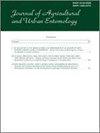加勒比Drywood白蚁Incitermes schwarzi的种群结构
Q2 Agricultural and Biological Sciences
The Journal of Agricultural and Urban Entomology
Pub Date : 2020-09-10
DOI:10.3954/1523-5475-36.1.101
引用次数: 1
摘要
西印度动物的分布是由当前新生代的水上传播以及多年前的其他传播方法形成的(Hedges 2001)。具体而言,白蚁在加勒比海的分布是由更新世晚期的旱地连接、漂浮的木材碎片和人类商业模式共同形成的(Scheffrahn等人,2006年,Evans等人,2013年)。漂浮的木屑被称为漂浮物,由于其长途飞行能力差,白蚁需要在水体中传播(Scheffrahn等人,2006)。此外,由于白蚁在飞行后找到资源后交配,两个个体必须各自飞行所需的长距离,然后相互定位,这一壮举不太可能发生(Scheffrahn等人,2009)。这种繁重的任务在能够单性生殖的物种中减轻了,目前只有14种白蚁具有这种特征(Matsuura 2010,Fougeyollas等人20152017,Fournier等人2016,Yashiro等人2018,Hellemans等人2019)。然而,最近的研究发现,在各种谱系中都存在单性生殖(Yashiro等人,2018,Hellemans等人,2019),这表明这种特征可能在白蚁中广泛存在。白蚁很容易被人类商业运输,因为它们秘密地在木材中觅食,木材是一种全球交易和运输的商品(Evans等人,2013)。在过去的500年里,海洋船只一直在远距离运送白蚁(Hochmair和Scheffrahn,2010年)。在佛罗里达州,入侵Coptotermes spp.的分布在海洋码头周围显著聚集(Hochmair和Scheffrahn,2010年)。据报道,在港口中发现了来自船上成熟群落的白蚁(Scheffrahn&Crowe,2011年),这有助于解释白蚁物种在全球传播的容易程度。枯木白蚁(Kalotermitidae)占已知入侵白蚁物种的近三分之一(28种中有9种;Evans等人2013),易于运输本文章由计算机程序翻译,如有差异,请以英文原文为准。
Population Structure of the Drywood Termite Incisitermes schwarzi (Blattodea: Kalotermitidae) in the Caribbean
West Indian animal distributions are shaped by overwater dispersal in the current, Cenozoic Era as well as other dispersion methods dating back many more years (Hedges 2001). Termites, specifically, have distributions in the Caribbean shaped by a combination of dry land connections in the late Pleistocene, floating wood debris, and human commerce patterns (Scheffrahn et al. 2006, Evans et al. 2013). Floating wood pieces, termed flotsam, are required for termite dispersal across bodies of water because of their poor long-distance flying ability (Scheffrahn et al. 2006). Additionally, since termites mate after locating a resource following their flight, two individuals must each fly the long distances required and then locate each other, a feat unlikely to occur (Scheffrahn et al. 2009). This onerous task is lessened in species capable of parthenogenesis, a trait currently known in only 14 termite species (Matsuura 2010, Fougeyrollas et al. 2015, 2017, Fournier et al. 2016, Yashiro et al. 2018, Hellemans et al. 2019). However, recent studies have found parthenogenesis across various lineages (Yashiro et al. 2018, Hellemans et al. 2019), suggesting that this trait may be widespread in termites. Termites are easily transported by human commerce because they cryptically forage in wood, a commodity that is globally traded and transported (Evans et al. 2013). Marine vessels have ferried termites across great distances for the past 500 years (Hochmair & Scheffrahn 2010). In Florida, the distributions of invasive Coptotermes spp. are significantly aggregated around marine docks (Hochmair & Scheffrahn 2010). Termite alates from mature colonies established on boats have been reported in harbors (Scheffrahn&Crowe 2011), helping to explain how easily termite species have been spread around the globe. Drywood termites (Kalotermitidae) make up nearly a third of known invasive species of termites (nine out of 28; Evans et al. 2013) and are easily transported
求助全文
通过发布文献求助,成功后即可免费获取论文全文。
去求助
来源期刊

The Journal of Agricultural and Urban Entomology
Agricultural and Biological Sciences-Insect Science
CiteScore
1.40
自引率
0.00%
发文量
2
期刊介绍:
The Journal of Agricultural and Urban Entomology (JAUE) (Journal of Agricultural Entomology, Jan 1984 - Oct 1998 volumes 1-15) is published under the auspices of the South Carolina Entomological Society (SCES). The Journal publishes contributions of original research concerning insects and other arthropods of agricultural and urban importance to include those affecting humans, livestock, poultry, and wildlife. JAUE is particularly dedicated to the publication of articles and notes pertaining to applied entomology, although it will accept suitable contributions of a fundamental nature related to agricultural and urban entomology.
 求助内容:
求助内容: 应助结果提醒方式:
应助结果提醒方式:


